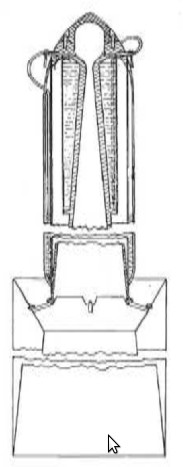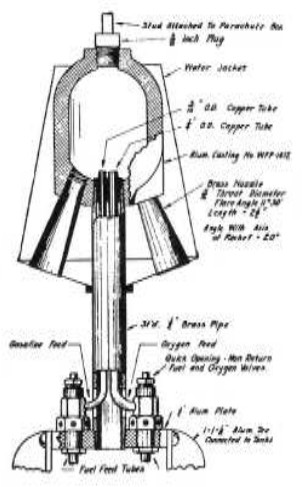Updated: 08-Jan-2020
From Appendixes A/2 and 3: AMERICAN ROCKET SOCIETY is a derivation and successor of the American Interplanetary Society (AIS).
-By ARS the rockets that were called AIS became ARS. The ARS #2, appears in another Appendix of this publication as AIS #2.

"Interesting diagram of the ARS #2"
-The "core" of the liquid fuel, oxygen-gasoline, rocket engine is inside in its upper part, where the stream of combustion gases flow through the hollow interior of the vehicle body.
-This gives more stability to the direction of the device.
-They made numerous tests with other special engines.
-One of them was one that we show below with a body of multiple parts so they could test with different chamber sizes.
-The weight, as being a ram-jet, was secondary.

"Test engine"
-The ARS #3 rocket continues with the inner chamber and it seems that it can be considered regenerative.

"The ARS #3 with annular wing"
-In the ARS #3 the ring fin acts as a "booster" device since the ambient air is induced inside this body and by the effect of the engine jet within the venturi.
-Now we have the ARS #4, this time with multiple nozzles directed backwards.

"The ARS #4"
-The entity was founded in 1930 under the name of American Interplanetary Society.
-The core members were scientific writers and it was in 1934 when the name was changed, because they did more experiments with engines and rockets than with other items.
-One of the first tests was the AIS #2. Later some members founded their own rocket engine companies.
-The Society discontinued its official tests after some accidents had occurred.

"AIS #2 rocket"
-In 1942 three of these members of the American Rocket Society founded the Rocket Motors Inc. also known as the RMI that would arrive to our days merged or absorbed, (see).
-At the NASM we find lose parts from the tests that were made by this society.
-For example, one of these engines was operating with liquid fuels. It had a wraparound casing with water circulating inside to cool the assembly. The materials were not as developed as they are now.
-Precisely the engine we are talking about, unfinished, was proposed for the AIS #2 rocket.

"ARS #2 rocket"
Engines of AMERICAN ROCKET SOCIETY
Model: ARS #2
Arquitecture: Rocket engine
Chambers: 0
Fuels: 0
Feed System:
Ignition:
Thrust:
Weight:
The "core" of the liquid fuel, oxygen-gasoline, rocket engine is inside in its upper part, where the stream of combustion gases flow through the hollow interior of the vehicle body.

"ARS #2 engine"
Model: ARS #3
Arquitecture: Rocket engine
Chambers:
Fuels:
Feed System:
Ignition:
Thrust:
Weight:
The ARS #3 rocket continues with the inner chamber and it seems that it can be considered regenerative.
In the ARS #3 the ring fin acts as a "booster" device since the ambient air is induced inside this body and by the effect of the engine jet within the venturi.

"The ARS #3 with annular wing"
Model: ARS #4
Arquitecture: Rocket engine
Chambers:
Fuels:
Feed System:
Ignition:
Thrust:
Weight:
Now we have the ARS #4, this time with multiple nozzles directed backwards.

"The ARS #4"


